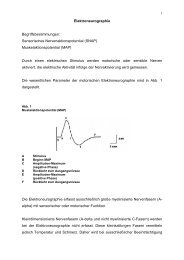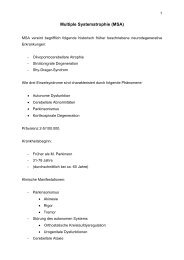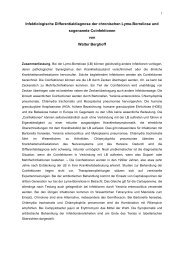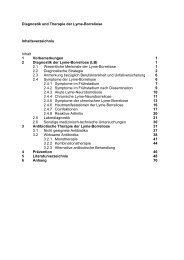Infectiologic differential diagnosis of chronic Lyme disease and so ...
Infectiologic differential diagnosis of chronic Lyme disease and so ...
Infectiologic differential diagnosis of chronic Lyme disease and so ...
Create successful ePaper yourself
Turn your PDF publications into a flip-book with our unique Google optimized e-Paper software.
13<br />
Bartonellae are localized in erythrocytes <strong>and</strong> cause deformations <strong>of</strong> the erythrocyte<br />
membrane [110 - 111].<br />
The visualization <strong>of</strong> the bartonellae in erythrocytes is already being used<br />
diagnostically, particularly al<strong>so</strong> with regard to the extent <strong>of</strong> the infection [101].<br />
However, irrefutable literature on erythrocyte infestation in <strong>chronic</strong> bartonelloses<br />
does not exist. The diagnostic value <strong>of</strong> a new method <strong>of</strong> detecting pathogens by<br />
means <strong>of</strong> cilia in blood smears cannot be assessed yet.<br />
The formation <strong>of</strong> intracellular blebs subsequent to penetration into the endothelial<br />
cells has al<strong>so</strong> been determined for Bartonella quintana, i.e. a similar process to that<br />
in <strong>Lyme</strong> <strong>disease</strong>. Moreover, Borrelia burgdorferi al<strong>so</strong> has a high affinity for<br />
endothelial cells, <strong>and</strong> the development <strong>of</strong> blebs, particularly in <strong>chronic</strong> di<strong>so</strong>rders, has<br />
been described. In connection with <strong>Lyme</strong> <strong>disease</strong>, the intracellular presence <strong>of</strong> the<br />
pathogen <strong>and</strong> the formation <strong>of</strong> biologically less active eukaryotic forms (cyst forms,<br />
blebs) have been discussed as the cause <strong>of</strong> the failure <strong>of</strong> antibiotic treatment. In<br />
addition, parallels between <strong>Lyme</strong> <strong>disease</strong> <strong>and</strong> bartonellosis have been found [cf.<br />
112 - 117].<br />
Table 8<br />
Symptomatology <strong>of</strong> bartonellosis<br />
Transmission modes /Vectors:<br />
Bite or scratch wounds (dog, cat)<br />
(saliva, claws)<br />
Flea bites<br />
Flea feces (oral)<br />
Lice<br />
Flies<br />
Gadflies<br />
Dust mites<br />
Blood transfusions<br />
Mother-child transmission













